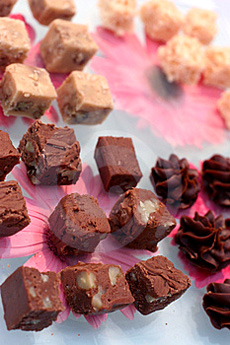
 Chocolate, vanilla, maple...from its basic beginnings, there are now dozens of flavors of fudge. Photo © Belle Media | Dreamstime.
Chocolate, vanilla, maple...from its basic beginnings, there are now dozens of flavors of fudge. Photo © Belle Media | Dreamstime.
|
KAREN HOCHMAN is Editorial Director of THE NIBBLE.
|
|
June 2007
Last Updated June 2016
|
 |
The Origin Of Fudge
Oh, Fudge! That’s How The History Of Fudge Began
CAPSULE REPORT: While many of our favorite sweets have ancient origins—ice cream, in the form of fruit ice, dates back 5,000 years—fudge is a relatively recent invention, probably dating to the late 1880s. And, it’s an American original! It may look like a simple confection, but, as anyone who has tried to make fudge from the original recipe of chocolate, cream, butter and sugar knows, it’s tricky (hence so many “foolproof” recipes with marshmallow creme, corn syrup, sweetened condensed milk, etc.) Here, the short history of fudge.
Fudge History
Fudge is a drier version of fondant,* made by boiling sugar in milk to the soft-ball stage and then beating the mixture while it cools so that it acquires a smooth, creamy texture. Fudge is an American invention: Some food historians peg the date to February 14, 1886, but the exact origin and inventor are disputed. Most stories claim that the first batch of fudge resulted from an accident with a bungled (“fudged”) batch of caramels, when the sugar was allowed to recrystallize; hence the name from the interjection, “Oh fudge!”
*An icing made of sugar syrup and glucose, or sugar, water and cream of tartar, cooked to the soft-ball stage and then kneaded to a smooth, soft paste. The paste can be colored or flavored and used as a center for chocolates or as an icing for cakes—it is especially popular as a covering for wedding cakes—and petit fours.
One of the first documentations of fudge is in a letter written by Emelyn Battersby Hartridge, then a student at Vassar College in Poughkeepsie, New York. She wrote that a schoolmate’s cousin made fudge in Baltimore in 1886 and sold it for 40 cents a pound. She obtained the recipe, and in 1888, made 30 pounds of it for the Vassar Senior Auction. Word of the confection spread to other women’s colleges. Wellesley and Smith developed their own versions of this “original” fudge recipe. All three recipes follow on Page 2.
The original fudge recipes were famously delicate: Precise measurements, cooking time and constant stirring were crucial for perfect fudge. The recipe looks simple—heat a mixture of sugar, butter and milk or cream to the soft-ball stage (224°-238°F), then beat it to a smooth, creamy consistency while it cools. But it is easy to undercook or overcook a batch (not every home cook had—or has—a candy thermometer) and to end up with “crystallized” fudge through insufficient stirring.
As a result, “foolproof” recipes were developed for the home cook that included corn syrup, which prevents crystallization and produces smooth fudge. Later recipes substituted sweetened condensed milk, marshmallow creme, or other ingredients for the milk/cream that were better guarantees of a perfect fudge texture. Of course, they didn’t guarantee the same creamy taste as the original recipe, which is provided on Page 2. If you want the best-tasting fudge, forget the sweetened condensed milk, corn syrup and marshmallow cream and go for the original ingredients.
Continue To Page 2: The Original Fudge Recipes
Go To The Article Index Above

|




